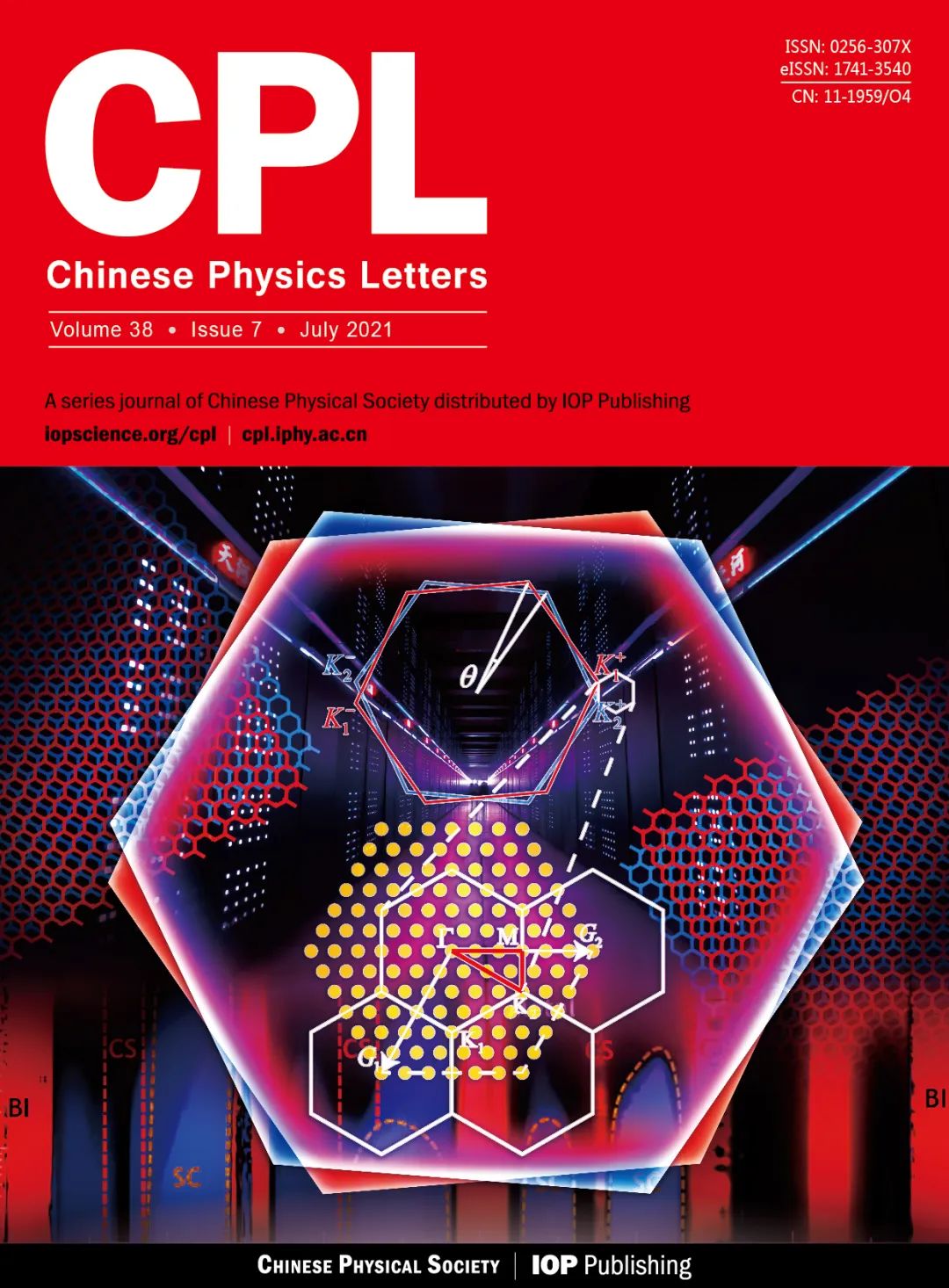博文
同行点评 | 动量空间中的量子蒙特卡洛模拟
|

原文已发表在CPL Viewpoints栏目
Received 10 March 2022;
published online 11 April 2022
Viewpoint
Quantum Monte Carlo Simulations in Momentum Space
Xi Dai (戴希)
Chin. Phys. Lett. 2022, 39 (5): 050101
应编辑部邀请,香港科技大学戴希教授撰写了这篇论文,深度点评了发表在CPL的一篇Express Letter。
原文链接
HTML
EXPRESS LETTER
Momentum Space Quantum Monte Carlo on Twisted Bilayer Graphene
Xu Zhang (张栩), Gaopei Pan (潘高培), Yi Zhang (张燚), Jian Kang (康健), and Zi Yang Meng (孟子杨)
Chin. Phys. Lett. 2021 38 (7): 077305
文章亮点
文章发展了动量空间量子蒙特卡洛算法,处理转角石墨烯等二维量子材料中涌现出的长程库伦相互作用问题。
原文链接
HTML

近几年来,随着转角石墨烯,过渡金属二硫化物等更加优异的二维关联量子材料的出现,尤其是这些材料中也观察到了关联绝缘体、超导等短程相互作用材料(如高温超导)和模型(如 Hubbard 模型)中常见的典型量子多体物态 (见文献 [1]),如何求解长程库伦相互作用,如何发展出像严格求解实空间短程相互作用的 Hubbard 模型的行列式量子蒙特卡洛算法等问题,就又被大家提起和关注。人们都知道,要想求解长程相互作用,需要走向动量空间。这是因为在实空间中,无论如何扩大截断范围,仍是短程相互作用,而与扩大截断范围所伴随的计算复杂度的增长,很快就会超出目前计算能力的极限。问题是,谁能成功地走出第一步,成功地在动量空间的相互作用模型中发展出量子蒙特卡洛算法,得到正确的结果,为后续的进展指出方向。
这篇文章就是回应这普适追求的一个尝试,相关结果发表在CPL (见文献[2]),中文介绍见文献[3]。作者发现采用动量空间的转角石墨烯有效模型,考虑长程库伦相互作用(投影到平带),在一些参数范围内可以用行列式量子蒙特卡洛方法严格求解,也从数学上证明了算法可以有效工作的原因(术语叫如何避免符号问题)。当然这只是开始,还有太多需要完善的地方,比如如何考虑材料中实际的能带效应,如何在动量空间中计算不同的物理可观测量等。这些具有普遍意义的问题就是吸引着从业人员不断追求下去的动力。
参考文献:
[1] 转角石墨烯的三昧, 物理, 2021, 50(5): 348-352
[2] Momentum Space Quantum Monte Carlo on Twisted Bilayer Graphene
Xu Zhang, Gaopei Pan, Yi Zhang, Jian Kang, Zi Yang Meng, Chin. Phys. Lett. 38, 077305 (2021) Express Letter
Quantum Monte Carlo Simulations in Momentum Space
Quantum Monte Carlo (QMC) methods are powerful numerical tools that can simulate quantum many-body problems with strong interactions among particles. Among them, determinant QMC is the most popular scheme which usually deals with the interacting fermions on a finite lattice system, such as the Hubbard model, Heisenberg model and periodical Anderson model. The key step of determinant QMC is to express the partition function that determines the thermal dynamical properties to a summation of terms with each of them being a “determinant” obtained by solving a corresponding non-interacting fermion model characterized by a set of Bosonic fields resulted from the “Hubbard–Stratonovich” transformation and Trotter decomposition.[1] Therefore, the determinant QMC maps a quantum many-body problem to a classical statistical problem if the determinant mentioned above is always positive and can be explained as some kind of probability. With the help of importance sampling and Metropolis process, the summation for the partition function can then be performed by considering random walk of the above Bosonic fields in the configuration space. Due to its simplicity, determinant QMC has been widely applied to various lattice Fermion models with strong local interactions as an unbiased way to conduct “numerical experiments”. The main problem that prevents the determinant QMC to achieve further success is the so-called “sign problem”, which is commonly encountered in many quantum many-body problems. The sign problem comes from the fact that the determinant associated with the each configuration is not always positive, which heavily reduces the efficiency of the importance sampling. The sign problem usually gets worse very quickly with the decrement of the temperature, which prevents the determinant QMC to be applied to enough low temperature, where the “quantumness” of the problem is about to fully emerged. Therefore, quantum systems with no or mild sign problems become very interesting because these problems can be efficiently studied by the QMC method, which allows us to take the full advantage of “Moore's law”.
Usually the property of no sign problem is not universal for all possible representations of the model. In most of the cases, it is only true for some special single particle basis set, where the smartly chosen way of rearranging the partition function guarantees that all the determinants involved have the same sign as a consequence of some unique symmetries. Recently, for a very important quantum many-body problem, the twisted bi-layer graphene systems,[2,3] Meng's group from Hong Kong University developed a completely new QMC scheme,[4] which works in momentum space instead of the real space to avoid the sign problem. Unlike the lattice Fermion models in the traditional strong correlated systems, the interacting electrons in TBG are more convenient to be described in the momentum space due to the following two reasons. First, the single particle wave functions, which are the basis of the correlation problems, extend as wide as several tens of lattice constants. Second, the effective interaction among those electrons near the Fermi level cannot be described as Hubbard-like short range interactions. Instead, it is the finite range screened Coulomb potential, which also covers tens of lattice constants. Professor ZiYang Meng and his collaborators revealed that the QMC scheme in momentum space provides a much natural description for the TBG systems and can have sign problem free for several different situations, which allows quite precise numerical simulation for this interesting new quantum many-body problem. The first round results from this new method on TBG were published in Ref. [4], which convincingly demonstrated the validity of the method by comparing with the exact solutions for some benchmark cases.[5] Considering the fact that new strongly correlated systems in 2D materials keep appearing in recent years, the new QMC method in momentum space developed by Meng's group will become more and more useful for future studies of related systems.
References
[1] Hirsch J E 1985 Phys. Rev. B 31 4403
[2] Bistritzer R and MacDonald A H 2011 Proc. Natl. Acad. Sci. USA 108 12233
[3] Cao Y, Fatemi V, Fang S, Watanabe K, Taniguchi T, Kaxiras E, and Jarillo-Herrero P 2018 Nature 556 43
[4] Zhang X, Pan G, Zhang Y, Kang J, and Meng Z Y 2021 Chin. Phys. Lett. 38 077305
[5] Bernevig B A, Lian B, Cowsik A, Xie F, Regnault N, and Song Z D 2021 Phys. Rev. B 103 205415
研究快讯集锦
用于拓扑量子器件的纯相超细InAs–Al纳米线原位分子束外延
α-CsPbI3的缺陷容忍性:高温相材料中点缺陷性质的计算方法
Valence Quark Ratio in the Proton
高混合熵提升非晶合金的能量状态
在可调耦合超导量子比特中实现全微波脉冲的CZ门
BaO/SrTiO3界面的电输运性质研究
高通量第一性原理计算探索潜在的笼目材料
氮的高压等结构相变
轨道转移矩驱动的垂直磁化无外场翻转
氟取代高分子在宏观和微观尺度上疏水特性的差异
Kitaev量子自旋液体候选材料α-RuCl3中分数化磁激发的证据
碳纳米管中的氮纳米管
赝厄米性保护幺正散射
非厄米反常贝里联络诱导的奇异输运现象
室温下自旋轨道转矩产生的20纳米斯格明子
Pauli Radius of the Proton
热还原氧化石墨烯膜中意外的锂选择性吸收
基于量子态的深度机器学习实现哈密顿量精确估计
重稀土氢化物的高温超导电性
多功能量子存储器
众里寻他千百度—量子磁体微观模型的多体计算自动寻参
量子自旋液体候选材料中低能激发的非局域效应
PT对称性诱导的激光阈值环及嵌在环上的连续谱中束缚态
半导体中掺杂行为随应变变化的基本规律
典型半导体材料在剪切应变下的本征超导电性
磁场中自旋轨道耦合系统的拓展Rashba解析近似方法研究
利用核四极矩共振和核磁共振研究笼目晶格超导体CsV3Sb5
库伦作用无尽期,动量蒙卡寄相思
二维金属硫代磷化物中的强磁电耦合效应
锶原子光晶格钟上的弗洛凯精密调控:拉比谱及灵敏度
Kagome化合物CsV3Sb5单晶超导态的各向异性
CsV3Sb5中高度稳定的超导再进入现象

点此浏览所有Express Letters
CPL Express Letters栏目简介
为了保证重要研究成果的首发权和显示度,CPL于2012年6月开设了Express Letters栏目。此栏目发表速度快,学术质量高。截至2020年底,平均每篇被引用约20次,已经在国内物理学界建立起良好口碑与声望,来稿数量不断增加。

https://blog.sciencenet.cn/blog-3426263-1335336.html
上一篇:研究快讯 | 锁相热扩散趋肤效应
下一篇:研究快讯 | 压力诱导具有超高能量密度的含氖聚合氮化物